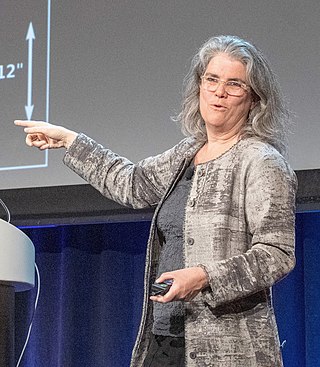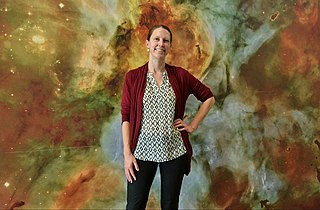Related Research Articles

Sandra Moore Faber is an American astrophysicist known for her research on the evolution of galaxies. She is the University Professor of Astronomy and Astrophysics at the University of California, Santa Cruz, and works at the Lick Observatory. She has made discoveries linking the brightness of galaxies to the speed of stars within them and was the co-discoverer of the Faber–Jackson relation. Faber was also instrumental in designing the Keck telescopes in Hawaii.

The American Astronomical Society is an American society of professional astronomers and other interested individuals, headquartered in Washington, DC. The primary objective of the AAS is to promote the advancement of astronomy and closely related branches of science, while the secondary purpose includes enhancing astronomy education and providing a political voice for its members through lobbying and grassroots activities. Its current mission is to enhance and share humanity's scientific understanding of the universe as a diverse and inclusive astronomical community.

Aleksander Wolszczan is a Polish astronomer. He is the co-discoverer of the first confirmed extrasolar planets and pulsar planets.

Michel Gustave Édouard Mayor is a Swiss astrophysicist and professor emeritus at the University of Geneva's Department of Astronomy. He formally retired in 2007, but remains active as a researcher at the Observatory of Geneva. He is co-laureate of the 2019 Nobel Prize in Physics along with Jim Peebles and Didier Queloz, and the winner of the 2010 Viktor Ambartsumian International Prize and the 2015 Kyoto Prize.
Karen J. Meech is an American planetary astronomer at the Institute for Astronomy (IfA) of the University of Hawaiʻi.
The Harold C. Urey Prize is awarded annually by the Division for Planetary Sciences of the American Astronomical Society. The prize recognizes and encourages outstanding achievements in planetary science by a young scientist. The prize is named after Harold C. Urey.

Andrea Mia Ghez is an American astrophysicist, Nobel laureate, and professor in the Department of Physics and Astronomy and the Lauren B. Leichtman & Arthur E. Levine chair in Astrophysics, at the University of California, Los Angeles. Her research focuses on the center of the Milky Way galaxy.
Catharine "Katy" D. Garmany is an astronomer with the National Optical Astronomy Observatory. She holds a B.S. (astrophysics), 1966 from Indiana University; and a M.A. (astrophysics), 1968, and Ph.D. (astronomy), 1971, from the University of Virginia. Catharine's main areas of research are massive stars, evolution and formation; astronomical education.
The Eberly College of Science is the science college of Penn State University, University Park, Pennsylvania. It was founded in 1859 by Jacob S. Whitman, professor of natural science. The College offers baccalaureate, master's, and doctoral degree programs in the basic sciences. It was named after Robert E. Eberly.

Claudia Megan Urry is an American astrophysicist, who has served as the President of the American Astronomical Society, as chair of the Department of Physics at Yale University, and as part of the Hubble Space Telescope faculty. She is currently the Israel Munson Professor of Physics and Astronomy at Yale University and Director of the Yale Center for Astronomy and Astrophysics. Urry is notable not only for her contributions to astronomy and astrophysics, including work on black holes and multiwavelength surveys, but also for her work addressing sexism and sex equality in astronomy, science, and academia more generally.

Heather A. Knutson is an astrophysicist and professor at California Institute of Technology in the Division of Geological and Planetary Sciences. Her research is focused on the study of exoplanets, their composition and formation. She won the American Astronomical Society's Newton Lacy Pierce Prize in Astronomy for her work in exoplanetary atmospheres.
Sarah T. Stewart-Mukhopadhyay is an American planetary scientist known for studying planet formation, planetary geology, and materials science. She is a professor at the University of California, Davis in the Earth and Planetary Sciences Department. She was a professor at Harvard University Department of Earth and Planetary Sciences from 2003 to 2014.

Smadar Naoz is an Israeli-American astrophysicist, and was the 2015 winner of the Annie Jump Cannon Award in Astronomy for her scientific contributions to the fields of cosmology and planetary dynamics.

Ruth Murray-Clay is a professor at the University of California Santa Cruz who studies the formation of planetary systems.

Vassiliki Kalogera is a Greek astrophysicist. She is a professor at Northwestern University and the director of the Center for Interdisciplinary Exploration and Research in Astrophysics (CIERA). She is a leading member of the LIGO Collaboration that observed gravitational waves in 2015.

Mercedes Tharam Richards, née Davis, was a Jamaican astronomy and astrophysics professor. Her investigation focused on computational astrophysics, stellar astrophysics and exoplanets and brown dwarfs, and the physical dynamics of interacting binary stars systems. However, her pioneering research in the tomography of interacting binary star systems and cataclysmic variable stars to predict magnetic activity and simulate gas flow is her most known work.

Lynnae C. Quick is an American planetary geophysicist and Ocean Worlds Planetary Scientist at NASA Goddard Space Flight Center. Her research centers on theoretical modeling of cryovolcanic processes on the icy moons and dwarf planets in the Solar System as well as modeling volcanic activity on Venus and the Moon. Quick is a member of the Dawn, Europa Clipper, and Dragonfly Mission science teams. She is also a member of the NASA Solar System Exploration Research Virtual Institute (SSERVI) Toolbox for Research and Exploration (TREX) team, and serves as co-chair of the Earth and Planetary Systems Sciences section of the National Society of Black Physicists.

Péter István Mészáros is a Hungarian-American theoretical astrophysicist, best known for the Mészáros effect in cosmology and for his work on gamma-ray bursts.

Laura Kreidberg is an American astronomer who primarily studies exoplanets. Since 2020, she has been director at the Max Planck Institute for Astronomy (MPIA) in Heidelberg, where she is leading the Atmospheric Physics of Exoplanets (APEx) department. She is MPIA's managing director as of January 2024.
References
- ↑ "Rebekah (Bekki) Dawson". www.personal.psu.edu.
- ↑ Wenz, John (October 10, 2019). "Lessons from scorching hot weirdo-planets". Knowable Magazine. Annual Reviews. doi: 10.1146/knowable-101019-2 . Retrieved April 4, 2022.
- ↑ Dawson, Rebekah I.; Johnson, John Asher (September 14, 2018). "Origins of Hot Jupiters". Annual Review of Astronomy and Astrophysics. 56 (1): 175–221. arXiv: 1801.06117 . doi:10.1146/annurev-astro-081817-051853 . Retrieved April 5, 2022.
- ↑ "Her CV" (PDF). psu.edu.
- ↑ "Dawson honored with Shaffer Career Development Professorship in Science".
- ↑ "Eberly College of Science tenure-line promotions in academic rank, effective July 1, 2021 | Eberly College of Science". science.psu.edu. Retrieved December 23, 2021.
- ↑ "Annie Jump Cannon Award in Astronomy - American Astronomical Society". aas.org.
- ↑ "Rebekah Dawson awarded Annie Jump Cannon Award in Astronomy - Penn State University". psu.edu.
- ↑ "2018 Fellows". sloan.org.
- ↑ "2020 Prize Recipients | Division for Planetary Sciences". dps.aas.org. Retrieved December 23, 2021.
- ↑ "Rebekah Dawson awarded 2020 Harold C. Urey Prize | Penn State University". www.psu.edu. Retrieved December 23, 2021.
- ↑ "Helen B. Warner Prize for Astronomy | American Astronomical Society". aas.org. Retrieved December 23, 2021.
- ↑ "Dawson honored with Helen B. Warner Prize for Astronomy | Penn State University". www.psu.edu. Retrieved December 23, 2021.